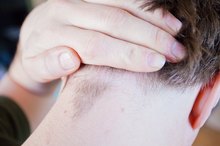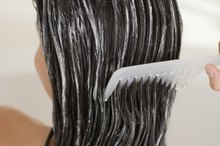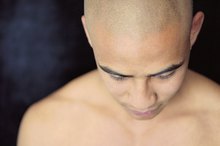The Baby is Pulling Out Her Hair
When you see your baby pulling out strands and tufts of her own hair, it can be unnerving. It's easy to jump to conclusions by thinking something is wrong with your baby, when it's actually a typical condition and somewhat common in small children. Most babies grow out of the habit, but you can prevent the hair pulling and ensure that it doesn't turn into a bigger problem.
Symptoms
While pulling hair is not uncommon in babies, occasionally you'll see adverse symptoms and side effects that can become worrisome. Baldness and bald patches can sometimes occur when your baby pulls from the same spot on her head. She might also have tender or red spots on her head because of the constant pulling. When the side effects begin to interfere with her development and disposition, hair pulling becomes a problem.
- While pulling hair is not uncommon in babies, occasionally you'll see adverse symptoms and side effects that can become worrisome.
- Baldness and bald patches can sometimes occur when your baby pulls from the same spot on her head.
Causes
Bald Patches in Children
Learn More
Most hair-pulling is the result of stress. Your baby likely pulls his hair when he's stressed, tired or nervous. Pulling hair is an effort by your child to control his environment, notes Babycenter.com. It could also be the result of trichotillomania, a psychological condition that causes children to pull out the hair of their body, according to Sydney Children's Hospital 1.
- Most hair-pulling is the result of stress.
- Pulling hair is an effort by your child to control his environment, notes Babycenter.com.
Prevention
One of the best ways to get your baby to stop pulling out her hair is to distract her so she doesn't think about it. If you notice your baby is reaching for her hair, hand her a small toy to play with instead. KeepKidsHealthy.com suggests a shorter haircut so your baby's hair isn't easily pulled. You might also consider small toys and objects that feel like hair, such as feathers and pipe cleaners that your baby can hold and play with.
- One of the best ways to get your baby to stop pulling out her hair is to distract her so she doesn't think about it.
Discipline
Underarm Hair in Girls
Learn More
In most cases, discipline for hair pulling is unnecessary. Your small baby won't understand, and will likely grow out of the habit. Never pull your child's hair or discipline her for what might be an unnoticed habit. Instead, gently remove the hair from your baby's hand and redirect his attention without offering punishment.
- In most cases, discipline for hair pulling is unnecessary.
- Never pull your child's hair or discipline her for what might be an unnoticed habit.
Medical Help
In rare cases, when the hair pulling is diagnosed as trichotillomania, your baby will need medical help, notes the University of Michigan Health System. Psychological therapy might be used to evaluate why your baby continues to pull out her hair, and even medications used for obsessive compulsive disorder. See your doctor if the hair-pulling seems more than just a mindless habit and more of a ritual for your baby.
Related Articles
References
- Sydney Children's Hospital: Factsheet--Trichotillomania
- University of Michigan: Bad Habits/Annoying Behavior
- Harrison JP, Franklin ME. Pediatric trichotillomania. Curr Psychiatry Rep. 2012;14(3):188–196. doi:10.1007/s11920-012-0269-8
- Novak CE, Keuthen NJ, Stewart SE, Pauls DL. A twin concordance study of trichotillomania. Am J Med Genet B Neuropsychiatr Genet. 2009;150B(7):944-9. doi:10.1002/ajmg.b.30922
- Franklin ME, Zagrabbe K, Benavides KL. Trichotillomania and its treatment: a review and recommendations. Expert Rev Neurother. 2011;11(8):1165–1174. doi:10.1586/ern.11.93
- Chamberlain SR, Menzies L, Sahakian BJ, Fineberg NA. Lifting the veil on trichotillomania. Am J Psychiatry. 2007;164(4):568-74. doi:10.1176/ajp.2007.164.4.568
- The TLC Foundation for Body-Focused Repetitive Behaviors. What is trichotillomania (hair pulling disorder)?.
Writer Bio
Kay Ireland specializes in health, fitness and lifestyle topics. She is a support worker in the neonatal intensive care and antepartum units of her local hospital and recently became a certified group fitness instructor.









